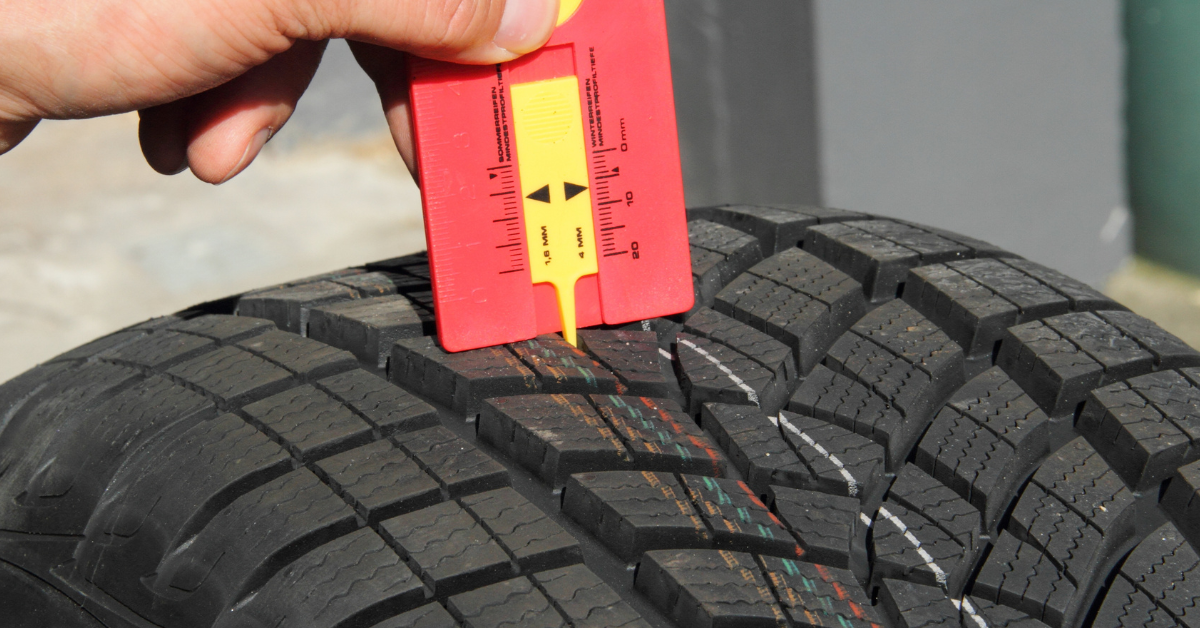
Tyres are the only parts of your car that are in contact with the road, and braking, stopping distance, cornering and fuel efficiency all depend on the condition of your tyres. So, when it comes to car tyre safety, it's important to remember a few key things: the tread depth, tyre pressure, the sidewalls, and the overall condition of your tyres.
Let’s go through how to perform a tyre safety check.
How to check the tyre pressure is correct and why this is important
It's important to check your tyre pressure regularly to ensure it's at the correct level. Driving with incorrect tyre pressure can damage your tyres, leading to increased accident risk.
You can easily find the best pressure level for your car by checking inside the driver’s door opening for the manufacturer's sticker.
To set the correct tyre pressure, remove the cap from the tyre nozzle and push the air pump into it to see the gauge window showing the tyre's current pressure. It will have a scale of 0 - 10 - 20 - 30 - 40 - 50 - 60 etc.
If the tyre pressure is lower than the sticker recommends, inflate it by squeezing the air trigger in short bursts until the pressure on the gauge reaches the correct level.
Under-inflated tyres can overheat the tyre, use up more fuel and increases the wear and tear. Overinflated tyres lead to harder than usual sidewalls and tread, and the tyre's contact patch with the ground gets smaller. This can decrease the traction and performance resulting in a bumpy ride, and compromised vehicle control.
How to check tread conditions and what to look out for
Checking tread depth is one of the most important things you can do to stay safe on the road. Your tyre’s tread depth helps the car grip the road and avoid skidding or sliding on wet or icy surfaces. As your tyres' tread wears, their ability to disperse water reduces. This means when conditions are wet, older tyres can increase the time it takes for your car to come to a stop.
The minimum legal tread depth in New Zealand is 1.5mm across 3⁄4 of the tread around the entire circumference of the tyre. However, it is recommended to maintain a tread depth of at least 3mm to avoid a reduction in tyre performance.
Here are a few ways you can check your tread depth yourself:
- Measure the depth with a tyre tread depth checker/gauge in three places - a ¼ of the way in from the outer edge, in the middle and ¼ away from the inner edge.
- You can use a 20c coin as a guide by inserting into the main grooves of the tyre in the same way as above. The base of the number 20 is approximately 2mm from the edge of the coin, so if you can see the whole of the number, that signals it's probably time for new tyres.
- Look out for wear indicators (shown as small blocks of rubber within the tread groove - when these appear level with the tyre surface , it's time for new tyres.
- It's also important to check the sidewalls of your tyres for any cracks, splits, or bulges, as these can be indicative of bigger problems.
- Alternatively, you can go to a local garage or tyre specialist and get them to check the tread depth and overall condition of your tyres for you.
WOF requirements for tyre safety
For your car to pass its Warrant of Fitness (WOF), it must have tyres that meet the safety requirements specified by the government. In short, they state that tyres on the same axle (front or back) must have the same fundamental characteristics.
This applies to:
- their size;
- what the tyre is made of (mixed steel ply, fabric radial ply, bias/cross-ply, run-flat), and;
- the tread pattern type (mixed asymmetric, directional, normal highway etc.)
If your tyres don't meet these requirements, you will need to replace them before you can get your car’s WOF. Luckily, our team at Suzuki can help you with that and can fit new tyres for you quickly and easily.
Where to find your tyre specifications
All the numbers and letters that appear on the outside of your tyre indicate the specifications of your tyre, such as manufacturer, brand, model, load rating, speed rating, standards marking and direction of rotation.
For example, if you have a 220/45 R17 91V XL tyre, this means it has:
- a width of 220 mm
- a profile height of 45% of the width (99 mm)
- rim diameter of 17 inches
- a load index 91 (maximum load 615 kg)
- the letter V indicates the top speed rating – 149 mph or 240 km/h
- XL means extra-load reinforced
- finally, the tyres must be rotated in the direction indicated by an arrow on the sidewall or side of the tyre.
Take some time to understand these specifications to ensure your tyres are suitable for your car and driving needs. Or ask a tyre specialist, garage or Suzuki service centre to recommend tyres that are suitable for you and your car.
Wrap up
Checking your tread depth, tyre pressure, and tyre tread wear indicators is quick and easy, and it could save your life. Be proactive – the small amount of effort involved can pay dividends in terms of enhancing your driving experience and extending the life of your tyres.
And if you’re looking to buy a new car - with brand new tyres, check out our Ultimate Car Buying Guide.



